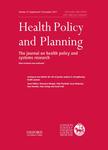版权所有:内蒙古大学图书馆 技术提供:维普资讯• 智图
内蒙古自治区呼和浩特市赛罕区大学西街235号 邮编: 010021

作者机构:Tulane Univ Global Hlth Management & Policy Sch Publ Hlth & Trop Med 1440 Canal StSuite 1900 New Orleans LA 70112 USA Kinshasa Sch Publ Hlth Kinshasa DEM REP CONGO
出 版 物:《HEALTH POLICY AND PLANNING》 (卫生政策与规划)
年 卷 期:2016年第31卷第8期
页 面:1058-1068页
核心收录:
学科分类:12[管理学] 1204[管理学-公共管理] 120402[管理学-社会医学与卫生事业管理(可授管理学、医学学位)] 1004[医学-公共卫生与预防医学(可授医学、理学学位)] 10[医学]
主 题:Accessibility Democratic Republic of the Congo evidence-based programming geographic information systems family planning Kinshasa
摘 要:While geographic information systems (GIS) are frequently used to research accessibility issues for healthcare services around the world, sophisticated spatial analysis protocols and outputs often prove inappropriate and unsustainable to support evidence-based programme strategies in resource-constrained environments. This article examines how simple, open-source and interactive GIS tools have been used to locate family planning (FP) services delivery points in Kinshasa (Democratic Republic of Congo) and to identify underserved areas, determining the potential location of new service points, and to support advocacy for FP programmes. Using smartphone-based data collection applications (OpenDataKit), we conducted two surveys of FP facilities supported by partner organizations in 2012 and 2013 and used the results to assess gaps in FP services coverage, using both ratio of facilities per population and distance-based accessibility criteria. The cartographic outputs included both static analysis maps and interactive Google Earth displays, and sought to support advocacy and evidence-based planning for the placement of new service points. These maps, at the scale of Kinshasa or for each of the 35 health zones that cover the city, garnered a wide interest from the operational level of the health zones Chief Medical Officers, who were consulted to contribute field knowledge on potential new service delivery points, to the FP programmes officers at the Ministry of Health, who could use the map to inform resources allocation decisions throughout the city.